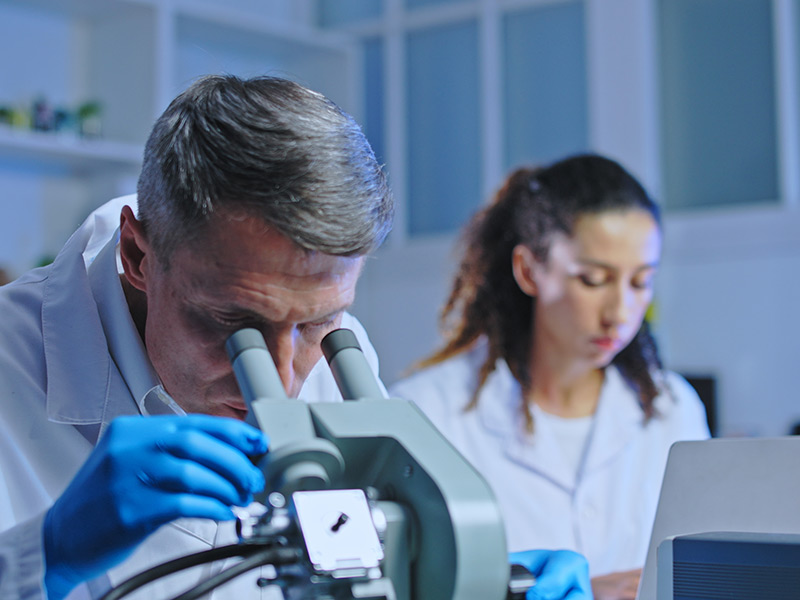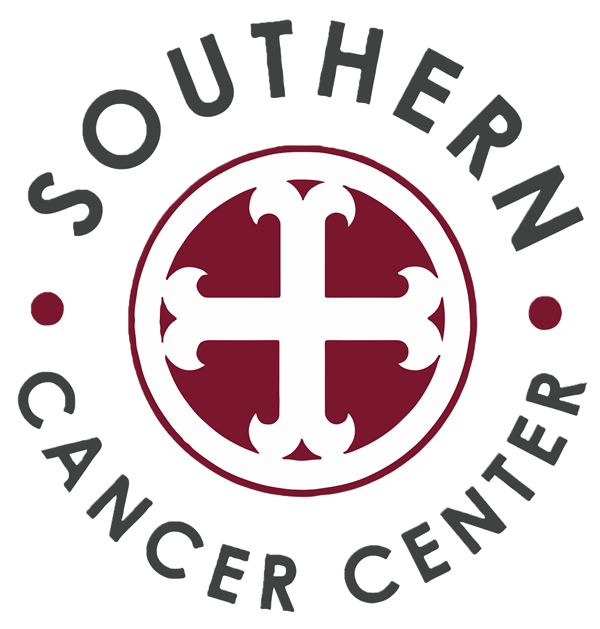A pathology report is essential to the diagnostic process. After a biopsy or breast cancer surgery, a pathologist will evaluate tissue and fluid samples and provide an analysis. This analysis will outline significant findings that will help your care team determine the best next steps. Whether a biopsy sample contains normal, pre-cancerous, or cancerous cells, the pathology report will note and describe all data assessed.
“A pathology report helps us determine the best treatment options for our patients,” said Dr. Reece Jones, medical oncologist at Southern Cancer Center. “It’s a critical tool that helps us guide patient care.”

What Does My Report Include?
Patient verification: Patient identification, procedure date, and lab and pathologist contact information. This section should be double-checked to verify that you have received the correct report.
Specimen description: A brief explanation of where the tissue samples were removed. For example, the breast, lymph nodes or both.
Clinical history & diagnosis: Information about the patient’s specific health issue, details about the biopsy or surgery, and the doctor’s pre-pathology diagnosis.
Gross (macroscopic) description: Summary of the tissues removed, including size, weight, color, texture, or other distinguishing features.
Microscopic description: The pathologist’s description of the tissues viewed at a microscopic level. It includes a comprehensive assessment:
If cancer cells are found, the pathologist will describe whether the cells have stayed in place or spread. Noninvasive cancer remains in the breast’s milk ducts or lobules (milk-producing glands). This type of cancer is called an in-situ carcinoma.
If the cancerous cells grow beyond the ducts or lobules into other tissues, it is called an invasive or infiltrating carcinoma.
You may see the following descriptions:
Ductal Carcinoma In Situ (DCIS): Cancer is not invasive and remains in the milk ducts.
Lobular Carcinoma in Situ (LCIS): An overgrowth of cells in the lobules. It is not cancer but indicates an increased risk of developing invasive cancer in the future. It is a rare condition.
Invasive Ductal Carcinoma (IDC): Cancer that develops in the milk ducts and grows into the surrounding breast tissues. This is the most common type of breast cancer.
Invasive Lobular Carcinoma (ILC): Cancer that starts inside the lobules and grows into the surrounding breast tissues.
Grade: A histologic grade describes how similar or different the cancer cells are from normal breast cells. The tumor grade is different than the cancer stage.
Grading scales may include the Scarff-Bloom-Richardson (SBR) numeric system or one of the following descriptions: well differentiated, moderately differentiated, or poorly differentiated.
Grade 1 or well differentiated: Cells look more like typical breast cells and are usually slower growing.
Grade 2 or moderately differentiated: Cells are somewhat abnormal with features between well and poorly-differentiated cells.
Grade 3 or poorly differentiated: Cells are abnormal looking and are typically fast growing.
Speed of Cell Division: Also called the mitotic rate or Ki-67, which measures how quickly the cancer cells grow and divide to create more cancer cells. A higher number usually indicates a more aggressive cancer.
Tumor Margin: The margin is the area beyond the suspected cancer that is also removed during a biopsy or surgery. A positive or involved margin indicates there are cancer cells in the edges of the tissue sample and, therefore, most likely still in the body. A negative margin means no cancer cells are present in the outer edge of the tissue sample. Close means that cancer cells are not at the margin but close to it, and removal of a wider area of tissue may be necessary.
Vascular Invasion and Lymph Nodes: Vascular invasion describes the circulation of cancer cells in the breast’s lymph channels or blood vessels. The pathologist will report this issue as present or absent.
Lymph nodes are filters for the lymph channels and may trap cancer cells. Lymph nodes free of cancer are considered negative; lymph nodes with cancer cells are positive. The presence of cancer cells in each lymph node may be categorized as:
Microscopic: The presence of a few cancer cells that can only be seen with a microscope.
Gross: The presence of many cancer cells that can be seen or felt without a microscope.
Extracapsular Extension: Cancer that has spread outside the lymph node capsule or wall.
Additional Tests: Other tests may be used to check for the presence of specific hormone receptors (proteins) and genes. The results of these tests are often called the breast profile and play an important role in treatment planning.
Hormone receptors include estrogen receptors and progesterone receptors. If a cancer is ER-positive, the cancer cells contain receptors for estrogen. Similarly, if a cancer is PR-positive, the cells contain receptors for progesterone. Your cancer could be positive for one type of receptor and negative for the other.
Your report may use one of the following designations:
- A percentage between 0 and 100% indicates the number of receptor-positive cells out of 100 cells tested.
- The Allred score assigns a number between 0 and 8. The higher the score, the more hormone receptors were found.
- A designation of either positive or negative to indicate whether hormone receptors are present at all.
HER2 status is another section of the breast profile included in the pathology report. HER2 is a protein that is normally expressed on breast cells but may be overexpressed in some cancers. In these cases, the patient’s report will indicate a HER2-positive status, indicating the need for specific treatments.
Genetic testing is not part of a standard pathology report. If an inherited genetic mutation is suspected, a separate genetic test may be performed. Learn more about Southern Cancer Center’s Genetic Testing & Counseling program HERE.
Stage: Cancer staging organizes information using a common language that is understood by all members of your care team. It also helps provide insight into possible outcomes and informs treatment decisions.
Stage 0: Noninvasive breast cancer
Stage IA: Invasive breast cancer
Tumor measures up to 2 cm, and cancer
has not spread outside the breast into lymph nodes
Stage IB: Invasive breast cancer
Small clusters of cancer cells are found in the lymph nodes either with or without a tumor present in the breast; if present, the tumor is no more than 2 cm
Stage IIA: Invasive breast cancer
Cancer is found in one – three lymph nodes under the arm (axillary) or near the breastbone, either with or without a tumor present in the breast; if present, the tumor is no more than 2 cm
OR the breast tumor is larger than 2 cm but not greater than 5 cm, and cancer has not spread to the lymph nodes
Stage IIB: Invasive breast cancer
Cancer is found in one – three lymph nodes, and a breast tumor larger than 2 cm but not greater than 5 cm is present
OR the tumor is larger than 5 cm, but cancer has not spread to the lymph nodes
Stage IIIA: Invasive breast cancer
Cancer is found in four – nine lymph nodes with or without a tumor present; if present, the tumor may be any size
OR the tumor is larger than 5 cm and has spread to the lymph nodes
Stage IIIB: Invasive breast cancer
Tumor may be any size and has spread to the chest wall, causing swelling
OR cancer may have spread to up to nine axillary lymph nodes or the lymph nodes near the breastbone
Stage IIIC: Invasive breast cancer
Cancer has spread to 10 or more axillary lymph nodes, the lymph nodes around the collarbone, or the lymph nodes near the breastbone
Stage IV: Invasive breast cancer
Cancer has spread beyond the breast and lymph nodes to other parts of the body, also called metastatic or advanced cancer
Your pathologist will conclude with a summary and diagnosis to help you and your team discuss the best treatment options. Speak with your doctor if there are any issues you don’t understand and seek a second opinion if greater clarity is needed.
Sources:
https://sharedhealthmb.ca/files/breast-cancer-path-report-guide.pdf
understanding your biopsy results and pathology resorts – Google Search
